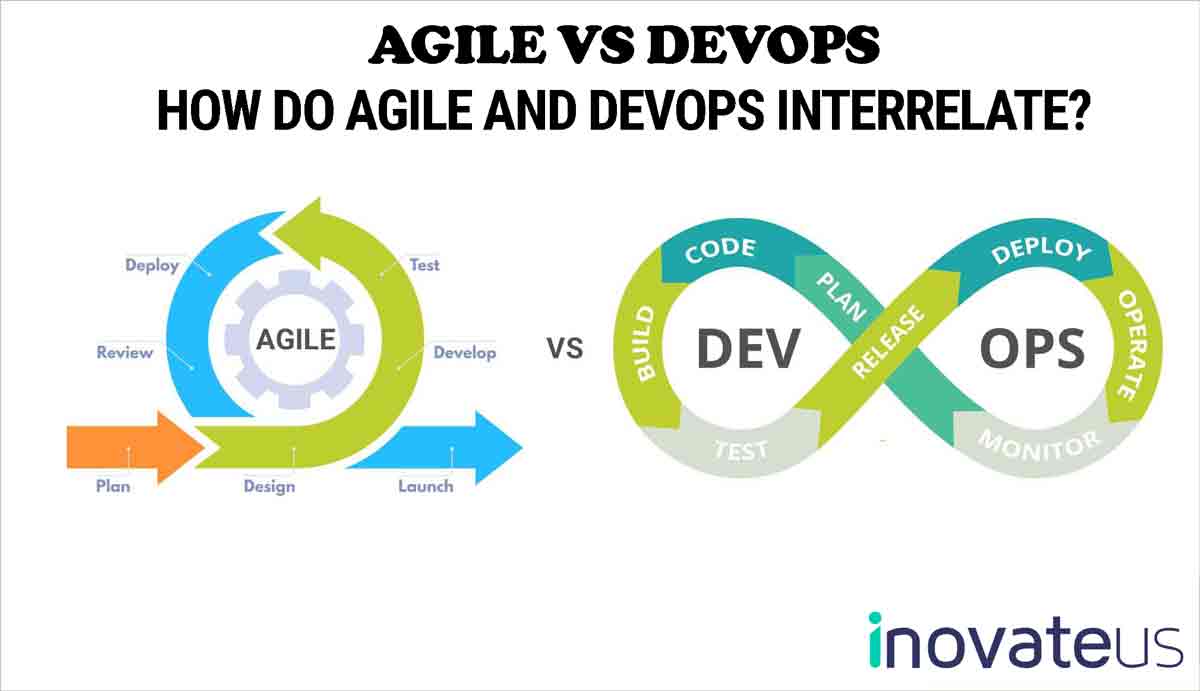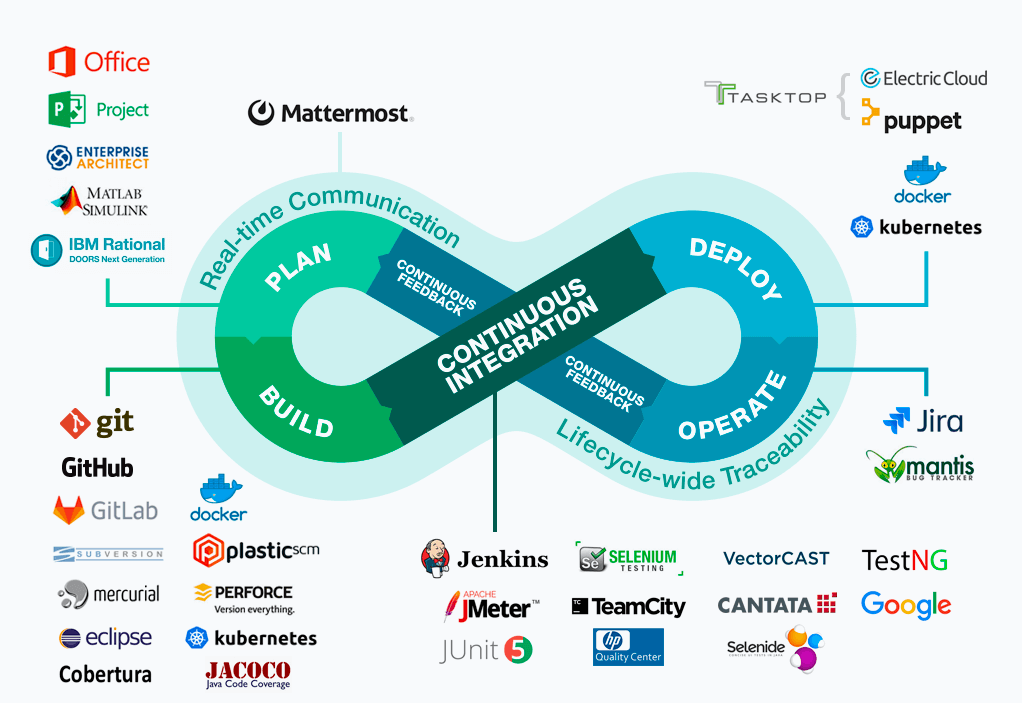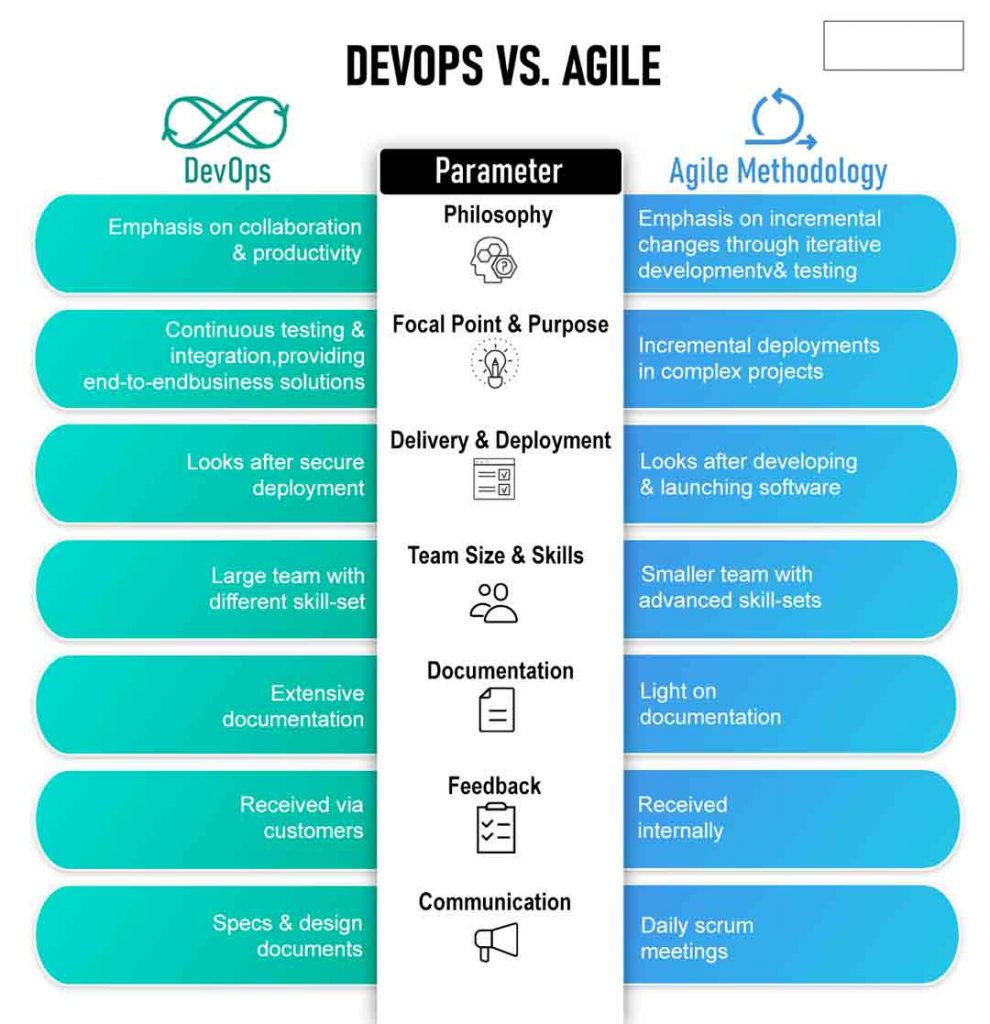Agile VS DevOps: How do Agile and DevOps interrelate?

There is a misconception that both, Agile and DevOps, cannot go together, but this is not true. Both of these methods work to make software successful in the market. Although the two perspectives are different, the mission is the same. If they work together, there will be no downtime or conflict in the software.
In this article, you will find all the information about how Agile and DevOps are interrelated? Over the past decade, DevOps and Agile have emerged as the most popular frameworks for developing software.
Although these two concepts look alike on the surface, they are pretty different from each other. In this article, we’ll explore how Agile and DevOps are linked by reviewing some of the critical aspects of their differences.
What is Agile?

The Agile method is based on repetitive and increasing progress, which requires dividing tasks into smaller pieces that can be completed in short cycles. It is a software development framework that allows teams to respond to change quickly and efficiently.
By using Agile methods, Novateus develops mobile applications. At Novateus, the dedicated team develops mobile apps incrementally through Agile methodology to optimize the development process while keeping all stakeholders in sync.
How does Agile work?
Agile is a growing approach to managing work using self-organizing teams, which provide feedback at every step. It allows teams to receive quick and frequent feedback from stakeholders, which helps them adjust as needed.
The Agile method is linked to three central values:
- Customer satisfaction through fast delivery of valuable software
- Constant focus on technical excellence and sound design
- A self-organized team that can respond quickly to change
Novateus follows the Agile methodology to promote custom software development. Therefore, Novateus prefers this method to maintain the customer in the loop during the product’s development.
Pros of Agile method:
-
Fast feedback:
With Fast Feedback, you can find changes in your business environment so you can respond accordingly. -
Fast adaption:
Development teams have faster response times to adapt to market conditions. In addition, by using the Agile methodology, Novateus develops mobile applications. -
Fast return:
You can maximize your return on investment by responding quickly to market time, earning time, or other similar metrics. -
Quick fixing:
It’s easy for an expert team to focus on their part and get involved in thinking about how things fit together. -
Reduce Loss:
Teams that use this method to respond more quickly help reduce overhead costs because fewer resources are wasted.
Cons of Agile method:
Need for a broad framework:
Although developers can work on small additions, these small additions need to fit into any of the broader frameworks you set up.
Ability to make a rapid change:
Your ability to make rapid changes is limited as long as you want to get everyone in motion whenever you need to adjust or change something.
What is DevOps?
DevOps is a set of methods used to communicate between software developers and system administrators. The primary purpose of this method is to shorten the feedback loop between the two groups, which ultimately leads to more efficient deployments and faster problem-solving.
How does DevOps work?

DevOps promotes communication, collaboration, and integration between dedicated software developers creating new applications. (Dev) and IT professionals who maintain and support these applications when they go live (Ops).
It combines methods and tools that help accelerate the organization’s delivery of applications and services. DevOps involves the rapid development and refinement of products. As a result, customer satisfaction makes your business successful in the marketplace.
By using the DevOps method, Novateus can increase your company’s response to the demands of the contemporary business environment. Where performance, agility, and impartial performance are now necessary, DevOps can reduce the cost of testing and deployment through cloud-based services and adoption.
Pros of using DevOps:
• Efficient:
Teams that use DevOps are more efficient because both the devs and the operation collaborate better, resulting in higher quality code in production.
• Fast testing:
DevOps ensures fewer errors, faster release, and better testing.
• Automation:
Companies can automate everything using the DevOps method, including processes, system tools, configuration management tools, network configurations, and more, as automation is an essential principle of DevOps.
• Quick and fast:
Faster, more frequent releases give users more codes
• Fast reduction of errors:
Successful DevOps organizations reduce their overall bug count by integrating continuous testing at every step of the process.
• Quick identification of bugs:
Deploying multiple times a day helps developers identify when a new bug was introduced in a previous release and see what changes trigger different bugs.
Cons of using DevOps:
• Difficulty in automation:
In some organizations, automated tasks have to go against cultural norms. As a result, many IT organizations are opposed to change, significantly increasing their workload.
• Difficult adaption:
It can be difficult for developers to adapt if they do not have much experience in writing scripts or if they know what tools are available.
How do Agile and DevOps interrelate?

Here are five keys ways that Agile and DevOps are interrelated:
1. Continuous integration and deployment (CI/CD):
The application of CI / CD principles for Agile development ensures that changes in production are always subject to rigorous testing before being deployed. As a result, it helps developers catch problems faster, resulting in fewer problems.
2. Automated testing:
When the tests are as automated as possible, they can run them continuously without compromising the quality of the code. This way, it ensures that the changes’ performance and the possible side effects are considered.
3. Refactoring and design principles:
The principles of refracting and design can also be applied to deployments through Agile development. The code is written in a more modular and reusable way, making it easier to deploy multiple versions of an application at once.
4. Rapid Feedback cycle between developers and System Administrators:
The constant exchanging feedback allows both parties to ensure that changes are made on time and that the final product meets consumer expectations.
5. Development flow and Release flow:
Agile control the development of software, while DevOps focuses on bringing the code into production and then improving the process. The corresponding methods are related to each other, and however, both are different; they are very interrelated.
Both are essential aspects of software development. Agile is the foundation of DevOps and enables teams to develop software faster. After that, new products are launched more frequently.
Conclusion:
So through the above discussion, you can see that Agile and DevOps work together to promote continuous improvement while minimizing the risk of unexpected issues affecting users. Furthermore, both parties can provide high-speed feedback cycles that help ensure the timely delivery of high-quality products by working together.

